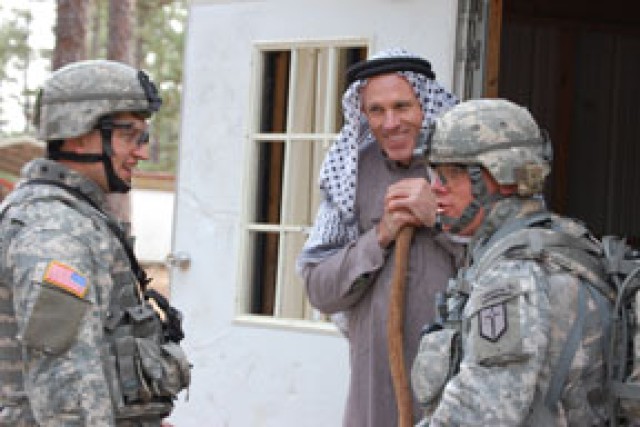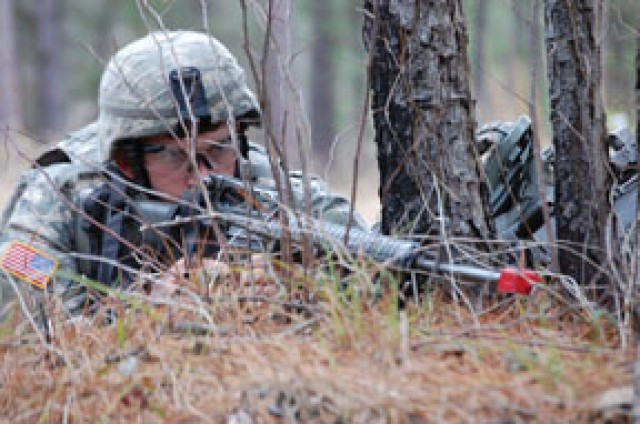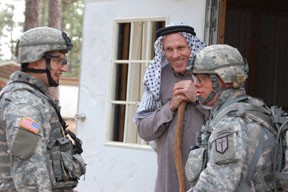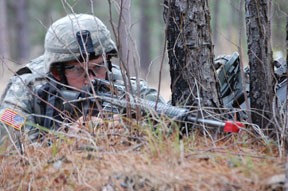FORT POLK, La. -- The 46th Engineer Battalion, 1st Maneuver Enhancement Brigade, Fort Polk, La., recently gave their senior leaders a "gut check" during a two-day exercise to test tactical and technical knowledge and offer a reminder that all Soldiers are "shooters first."
The Steel Spike Challenge is a test for senior leaders, mainly platoon leaders and platoon sergeants, to check their essential "warrior-leader" skills and their individual tasks, said Sgt. Maj. Tony James, 46th Engineer Battalion command sergeant major.
"We are reminding them that 'I am a shooter first and a technician second'. We are trying to build this mindset with the leadership first so that it can be passed on to troops at the lower levels," said James.
"Sometimes, when you are in a maneuver-type unit, you tend to get focused on your job," he said. "Sometimes, when you are in that type of unit, you lose sight of 'I'm always a shooter.' So we pulled together all senior leadership, and basically put them in two organizations, or platoons," he added. "Then we separate platoon sergeants and platoon leaders who historically work together into the two different platoons so there is no continuity."
The results are a "Survivor" type situation, said James. "You show up with people you never worked for and get handed a laundry list of tasks that you are going to execute over the next 36 hours and 'Oh by the way' we are going to do it carrying this amount of weight and you are going to do it on one meals ready to eat," James said. "So there is kind of a 'gut check' in there so it becomes a situation of mental toughness."
Tasks for the Steel Spike Challenge began at 6 a.m. with a six-mile run, said James. After the run, Soldiers began equipment issue and a mission brief to let them know what their next task was and where they would be going.
Each task required participants to travel to each point on foot. The challenge was composed of four main tasks: Executing a "shura," reinforce a local national traffic control point, a hasty bridge assessment and search for a weapons cache.
The first task required the participants to enter a mock local national village and execute a "shura," or conference with the village elder. However, as straightforward as this mission may have seemed to the Soldiers, they quickly learned that things can go bad in a matter of seconds.
"Once we entered the town and made contact with the elder, we heard explosions and found out that the village elder's son had been hit with indirect fire," said Sgt. 1st Class James Dean, platoon sergeant, 687th Engineer Co, 46th Eng Bn. "Then basically he wanted us to provide aid to his son and we were trying to develop a good rapport with him and he was kind of 'freaking out' because we were receiving indirect fire. It was chaos."
The second task was re-enforcing a local national traffic control point where the participants needed to bring supplies to local national police and see if anything else was needed. "There were a lot of things that had to take place with that task," said 2nd Lt. Garrett Anderson, platoon leader, 687th Eng Co. "We had to help to keep the peace with the local nationals while helping the TCP.
And with all of this, they had to conduct a resupply for the personnel manning the TCP by providing water and MREs," he said.
"The resupply added another challenge to us because we weren't used to carrying the extra weight and had to navigate through the woods on foot," added Dean. "These are things which we haven't focused training on much in the past but will definitely concentrate on in the future."
Next, participants had to assess the strength of a bridge which is a standard task for engineers, said James.
"The task required them to do an assessment on a bridge, a hasty assessment," James said. "How we put a bridge here, how we destroy a bridge here, whatever the case may be -- basically a hasty bridge assessment for a given piece of ground, he said."
The final task required Soldiers search for a possible weapons cache.
"From there, they moved back on foot to the battalion area, did a patrol debrief, conducted an after action review and enjoyed some rest and pizza," James said."
"Overall it was great training," said Dean. "Even though we were all senior leaders, no matter what rank you are in the Army, you can always learn something. I learned something about myself and the leadership styles of those I work with every day," he added. "I would really like to do this again."
Anderson agreed. "Altogether it was a well thought-out training event. It was a great way to get senior leadership together to pass out their wealth of knowledge to each other. It was awesome to gain all that knowledge. I think that more units should do something similar," he said.




Social Sharing